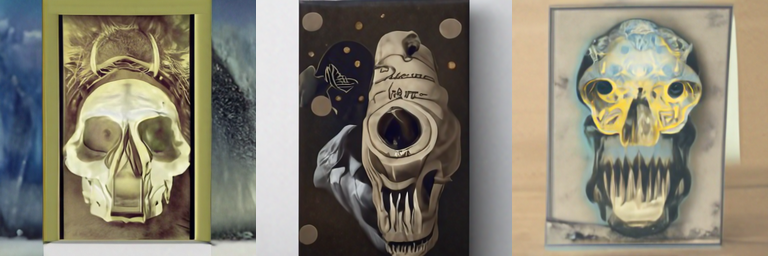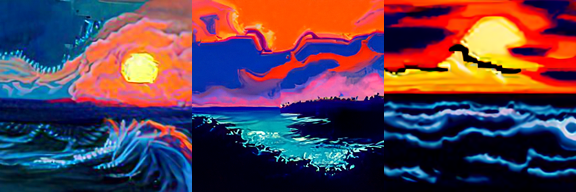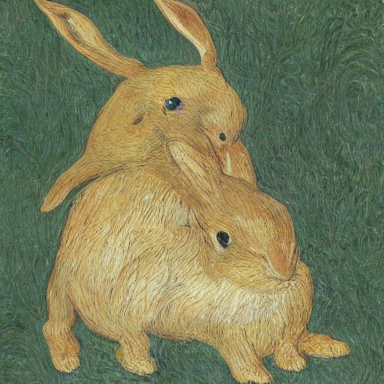laionide-v3
Maintainer: laion-ai

61

| Property | Value |
|---|---|
| Run this model | Run on Replicate |
| API spec | View on Replicate |
| Github link | View on Github |
| Paper link | View on Arxiv |
Create account to get full access
Model overview
The laionide-v3 model is a GLIDE model that has been finetuned on the large LAION5B dataset, and then further refined on curated datasets. It was developed by the LAION-AI team. Similar models include the DALLE2-PyTorch, stable-diffusion, and the CLIP-based CLIP-ViT-H-14-laion2B-s32B-b79K and CLIP-ViT-bigG-14-laion2B-39B-b160k models.
Model inputs and outputs
The laionide-v3 model takes a text prompt as input and generates an image that matches the prompt. The input prompt can describe a scene, object, or concept, and the model will attempt to create a corresponding visual representation.
Inputs
- prompt: The text prompt describing the desired image
- seed: An optional seed value for reproducibility
- side_x: The width of the generated image (must be a multiple of 8, max 64)
- side_y: The height of the generated image (must be a multiple of 8, max 64)
- batch_size: The number of images to generate at once (1-6)
- upsample_temp: The temperature parameter for the upsampling process (0.997, 0.998 or 1.0)
- guidance_scale: The classifier-free guidance scale (4-16 is a reasonable range)
- upsample_stage: Whether to perform prompt-aware upsampling by 4x
- timestep_respacing: The number of timesteps to use for the base model (40-50 is a good range)
- sr_timestep_respacing: The number of timesteps to use for the super-resolution model (17-40 is a good range)
Outputs
- An array of URIs pointing to the generated images
Capabilities
The laionide-v3 model is capable of generating photorealistic images from text prompts, much like other large language models such as DALL-E 2 and Stable Diffusion. It can create a wide variety of scenes, objects, and concepts, and the quality of the generated images is generally high. The model has been finetuned on curated datasets in addition to the large LAION5B dataset, which may improve its performance on certain types of prompts.
What can I use it for?
The laionide-v3 model could be used for a variety of creative and imaginative applications, such as:
- Generating images for illustrations, concept art, or visual storytelling
- Experimenting with different artistic styles and visual interpretations of text prompts
- Prototyping product designs or visualizing ideas
- Enhancing existing images through prompt-based editing and refinement
As with similar text-to-image models, it's important to consider the potential ethical and societal implications of using such systems, as they can potentially be misused or lead to the spread of misinformation or manipulated content.
Things to try
One interesting aspect of the laionide-v3 model is its ability to generate images that combine disparate elements in novel and unexpected ways, such as "The Lovers demon skull werewolf tentacle tarot card". Experimenting with prompts that blend different concepts, genres, or styles can yield surprising and thought-provoking results. Additionally, trying different values for the guidance scale and upsampling parameters can help fine-tune the balance between creativity and coherence in the generated images.
This summary was produced with help from an AI and may contain inaccuracies - check out the links to read the original source documents!
Related Models

laionide-v2

3
laionide-v2 is a text-to-image model from LAION-AI, a prominent AI research collective. It is a fine-tuned version of the GLIDE model from OpenAI, trained on an additional 30 million samples. This model can generate photorealistic images from text prompts. Compared to similar models like laionide-v3, laionide-v2 has a slightly smaller training dataset but may produce images with fewer artifacts. Other related models from LAION-AI include ongo, erlich, and puck, which specialize in generating paintings, logos, and retro game art respectively. Model inputs and outputs laionide-v2 takes a text prompt as input and generates a corresponding image. The model can output images at a range of resolutions, with the ability to generate upscaled versions of the base image. Key input parameters include the text prompt, image dimensions, and various hyperparameters that control the sampling process. Inputs Prompt**: The text prompt to use for generating the image Side X**: The width of the generated image in pixels (multiple of 8, up to 128) Side Y**: The height of the generated image in pixels (multiple of 8, up to 128) Batch Size**: The number of images to generate simultaneously (1-6) Upsample Stage**: Whether to perform prompt-aware upsampling to increase the image resolution by 4x Timestep Respacing**: The number of timesteps to use for the base model (5-150) SR Timestep Respacing**: The number of timesteps to use for the upsampling model (5-40) Seed**: A seed value for reproducibility Outputs Image**: The generated image file Text**: The prompt used to generate the image Capabilities laionide-v2 can generate a wide variety of photorealistic images from text prompts, including landscapes, portraits, and abstract scenes. The model is particularly adept at capturing realistic textures, lighting, and details. While it may produce some artifacts or inconsistencies in complex or unusual prompts, the overall quality of the generated images is high. What can I use it for? laionide-v2 can be a powerful tool for a range of applications, from creative content generation to visual prototyping and illustration. Artists and designers can use the model to quickly explore ideas and concepts, while businesses can leverage it for product visualizations, marketing materials, and more. The model's ability to generate high-quality images from text also makes it suitable for media production, educational resources, and other visual-centric use cases. Things to try Experiment with the model's various input parameters to see how they affect the generated images. Try prompts that combine specific details with more abstract or emotive language to see the model's ability to interpret and translate complex concepts into visuals. You can also explore the model's limitations by providing prompts that are particularly challenging or outside its training distribution.
Updated Invalid Date

laionide

7
laionide is a text-to-image generation model created by the LAION-AI team. It is built on top of the GLIDE model from OpenAI, which has been finetuned on a large dataset of around 30 million additional samples. This gives laionide the ability to generate high-quality images from text prompts quickly. Similar models created by LAION-AI include laionide-v2, which uses the same base model but with additional finetuning, and laionide-v3, which has been further improved with curation of the dataset. Model inputs and outputs laionide takes a text prompt as input and generates an image as output. The model supports additional configuration options like the image size, batch size, and guidance scale to fine-tune the generation process. Inputs Prompt**: The text prompt to use for generating the image. Seed**: A seed value for reproducibility. Side X/Y**: The width and height of the generated image in pixels. Must be a multiple of 8 and not above 64. Batch Size**: The number of images to generate at once, up to 6. Upsample Temp**: The temperature to use for the upsampling stage, typically around 0.997-1.0. Guidance Scale**: The classifier-free guidance scale, typically between 4-16. Upsample Stage**: A boolean flag to enable the prompt-aware upsampling step. Timestep Respacing**: The number of timesteps to use for the base model, typically 27-50. SR Timestep Respacing**: The number of timesteps to use for the upsampling model, typically 17-40. Outputs Image(s)**: The generated image(s) as a list of URIs. Capabilities laionide can generate a wide variety of photorealistic and stylized images from text prompts. The model is particularly adept at creating fantasy and surreal scenes, as well as abstract art and logo designs. It can also handle more complex prompts involving multiple elements, like "a werewolf tentacle tarot card on artstation". What can I use it for? With its ability to generate high-quality images from text, laionide can be a valuable tool for a range of creative projects. Artists and designers can use it to ideate and explore new concepts, while content creators can generate custom imagery for their projects. Businesses may find it useful for creating product visualizations, marketing assets, or even logo designs. Additionally, the model's speed and scalability make it suitable for applications that require real-time image generation, such as chatbots or interactive experiences. Things to try One interesting aspect of laionide is its ability to handle complex and specific prompts. Try experimenting with prompts that combine multiple elements, such as "a fantasy landscape with a castle, a dragon, and a wizard". You can also explore the model's stylistic capabilities by providing prompts that reference particular art styles or mediums, like "a cubist portrait of a person".
Updated Invalid Date

laionide-v4

9
laionide-v4 is a text-to-image model developed by Replicate user afiaka87. It is based on the GLIDE model from OpenAI, which was fine-tuned on a larger dataset to expand its capabilities. laionide-v4 can generate images from text prompts, with additional features like the ability to incorporate human and experimental style prompts. It builds on earlier iterations like laionide-v2 and laionide-v3, which also fine-tuned GLIDE on larger datasets. The predecessor to this model, pyglide, was an earlier GLIDE-based model with faster sampling. Model inputs and outputs laionide-v4 takes in a text prompt describing the desired image and generates an image based on that prompt. The model supports additional parameters like batch size, guidance scale, and upsampling settings to customize the output. Inputs Prompt**: The text prompt describing the desired image Batch Size**: The number of images to generate simultaneously Guidance Scale**: Controls the trade-off between fidelity to the prompt and creativity in the output Image Size**: The desired size of the generated image Upsampling**: Whether to use a separate upsampling model to increase the resolution of the generated image Outputs Image**: The generated image based on the provided prompt and parameters Capabilities laionide-v4 can generate a wide variety of images from text prompts, including realistic scenes, abstract art, and surreal compositions. It demonstrates strong performance on prompts involving humans, objects, and experimental styles. The model can also produce high-resolution images through its upsampling capabilities. What can I use it for? laionide-v4 can be useful for a variety of creative and artistic applications, such as generating images for digital art, illustrations, and concept design. It could also be used to create unique stock imagery or to explore novel visual ideas. With its ability to incorporate style prompts, the model could be particularly valuable for fashion, interior design, and other aesthetic-driven industries. Things to try One interesting aspect of laionide-v4 is its ability to generate images with human-like features and expressions. You could experiment with prompts that ask the model to depict people in different emotional states or engaging in various activities. Another intriguing possibility is to combine the model's text-to-image capabilities with its style prompts to create unique, genre-blending artworks.
Updated Invalid Date

ongo

133
The ongo model is a text-to-image generation model created by LAION-AI. It is based on the Latent Diffusion model and has been finetuned on the Wikiart dataset of paintings to improve its ability to generate artistic, painterly images from text prompts. This model can be contrasted with other text-to-image models like erlich, which is finetuned on logos, or stable-diffusion, which is trained on a broader set of internet images. Model inputs and outputs The ongo model takes a text prompt as its main input, along with several optional parameters to control the generation process, such as guidance scale, aesthetic rating, and initialization image. The model then generates a set of high-quality, artistic images that match the provided text prompt. Inputs Prompt**: The text description of the image you want to generate. Negative Prompt**: An optional text prompt that can be used to guide the model away from certain undesirable outputs. Init Image**: An optional starting image that the model can use to guide the generation process. Mask**: An optional mask image that specifies which parts of the init image should be kept or discarded during inpainting. Guidance Scale**: A parameter that controls the strength of the text prompt's influence on the generated image. Aesthetic Rating**: A parameter that allows you to specify a desired aesthetic quality for the generated image, on a scale of 1-9. Aesthetic Weight**: A parameter that controls the balance between the text prompt and the aesthetic rating. Outputs Generated Images**: The model outputs a set of images that match the provided text prompt, with the level of artistic style and quality influenced by the input parameters. Capabilities The ongo model excels at generating high-quality, painterly images from text prompts. It can create a wide variety of artistic styles and subjects, from realistic landscapes to abstract compositions. The model's finetuning on the Wikiart dataset gives it a strong understanding of artistic composition and color theory, allowing it to produce visually compelling and coherent images. What can I use it for? The ongo model can be used for a variety of creative and artistic applications, such as: Concept art and illustrations**: Generate visually striking images to accompany stories, articles, or other creative projects. Fine art and digital painting**: Create unique, one-of-a-kind artworks that capture a specific style or mood. Product and packaging design**: Generate logo designs, product mockups, and other visual assets for commercial applications. Things to try One interesting aspect of the ongo model is its ability to blend text prompts with specific aesthetic preferences. By adjusting the Aesthetic Rating and Aesthetic Weight parameters, you can guide the model to produce images that not only match your text prompt, but also have a particular visual quality or style. Experiment with different combinations of these parameters to see how they affect the generated images. Another intriguing feature of the ongo model is its support for inpainting, which allows you to provide an initial image and then have the model generate new content to fill in or modify specific areas. This can be a powerful tool for digital artists and designers who want to quickly iterate on existing concepts or refine specific elements of an image.
Updated Invalid Date